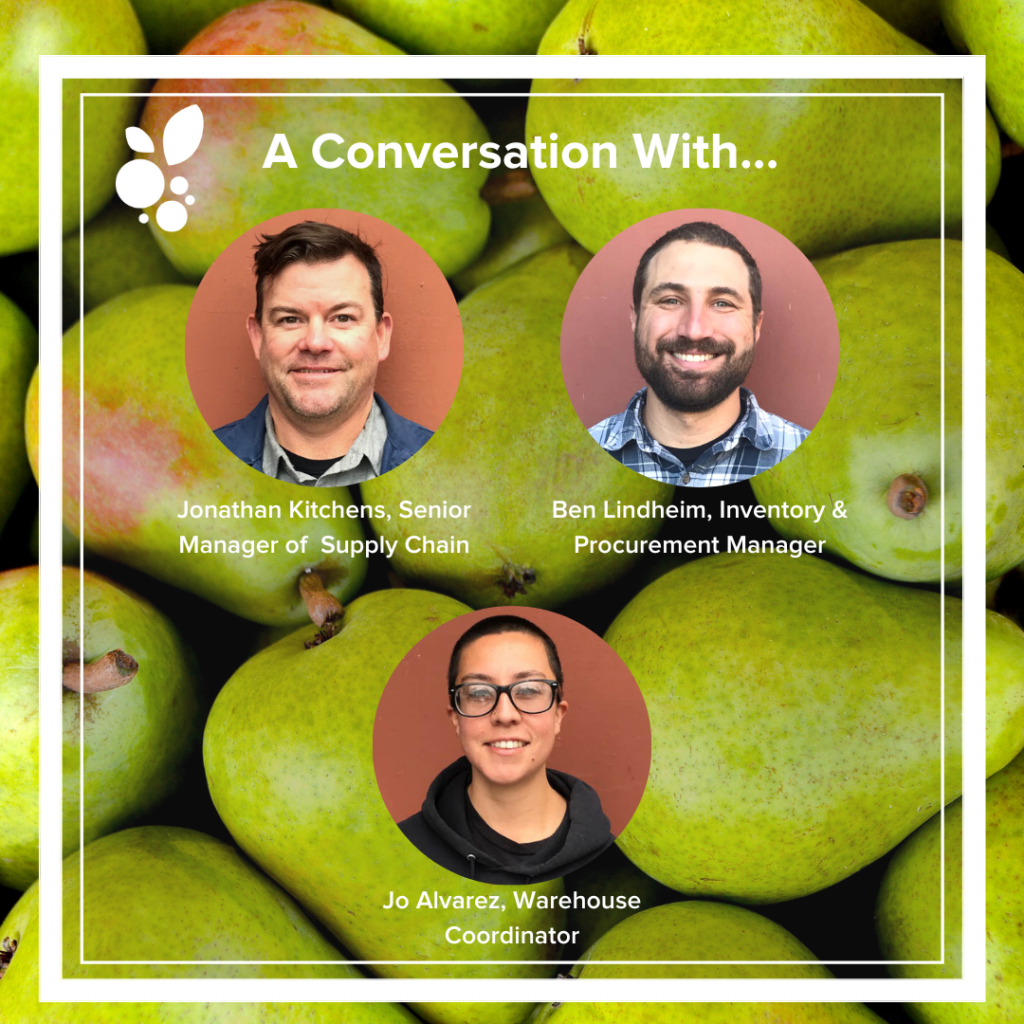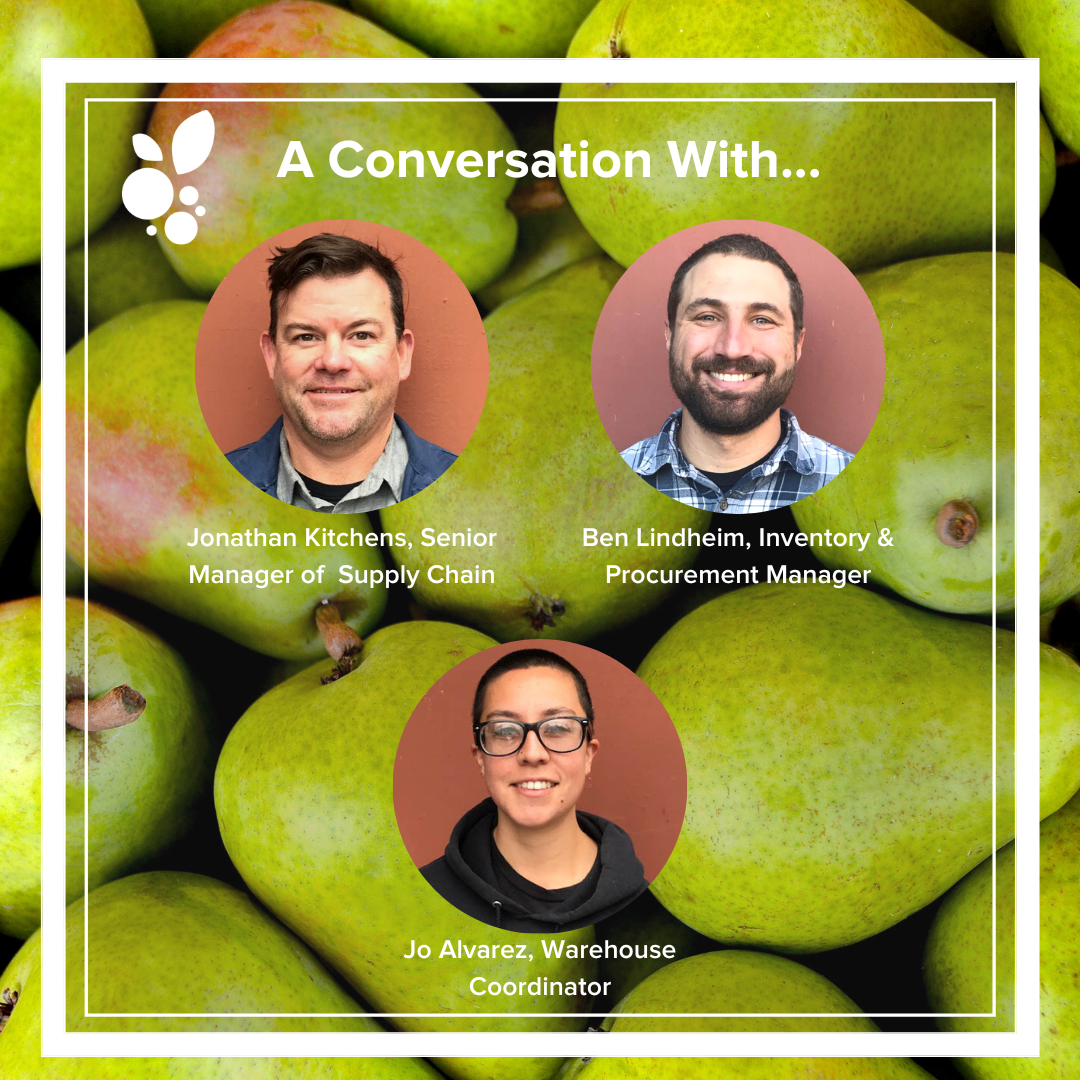
Jonathan Kitchens joined us last fall as Senior Manager of Supply Chain. Shortly after, Ben Lindheim was onboarded as BFN’s new Inventory & Procurement Manager, and Jo Alvarez was promoted to Warehouse Coordinator. Jonathan and his team, including three Warehouse Associates, have already made major improvements to the layout and functionality of the warehouse and to BFN’s inventory system. Jonathan is also making strides to refine our standards for obtaining food so BFN can be more strategic, value-aligned, and community-centric in how and what we source. Below is an interview with Jonathan and some new and recently-promoted members of his team about what’s ahead for sourcing and warehouse operations.
Jonathan, what are our biggest challenges with sourcing currently and what are you looking at shifting to overcome them this year?
Jonathan: The biggest challenge is understanding a complex existing web of stakeholders in our supply chain, so we can implement systems to serve them effectively and efficiently the foods they need. Our goal this year will be to implement systems with Andrew to understand that better. Then, we can expand beyond this current group of stakeholders, and more effectively and efficiently track our distribution numbers.
What we’re doing is more complicated than what anyone else is doing. We’re serving all kinds of people at all scales each with different preferences–from RDO partners, homebound deliveries, Hub Meals, and pantries. Most organizations do one of those services, we do all of them.
What are our current sourcing streams and how are you working to shift that mix this year?
Jonathan: Alameda County Community Food Bank (ACCFB) is a big source of donated food. We also get recovered food from grocery stores and individuals and have a purchasing budget to buy food primarily from growers in California. We are looking to grow our purchasing budget this year.
Why is it important to grow our purchasing budget when we already get donated and recovered food?
Jonathan: So much of the donated food is purchased, it’s a common myth that it’s not. The food we get from ACCFB (Feeding America) is purchased from farmers and producers with funds from USDA or others. Some of that food, especially from Feeding America, is not the food that is most desired by the people we serve. We’re trying to supplement with nutrient-dense items that are produced in a way that is aligned with our values. We’re trying to provide diversity in our items– the things that are not typically available in recovered or donated items such as alternative milks, tofu, herbs, culturally-relevant foods, and produce.
If we can use our buying power, experience, and relationships to aggregate high-quality items that people couldn’t get or are already too expensive and bring them here to one place, it removes another obstacle. That’s why we purchase food. I would like us all to think, “what if we were a free grocery store?” What are the actual lived negatives to that mindset? That’s how it was forever from time immemorial until we developed money. Access was there all the time. We’re trying to provide something radically different at BFN.
How do you decide or vet who BFN purchases from to ensure high quality and alignment with our values?
Jonathan: Right now we’re coming up with pillars of standards for purchasing and those will be fleshed out in the next couple of months. The idea is if we’re going to purchase, here are the vendors and growers where we want to start. For example, if we attempt to purchase from certified organic first, and if that’s not available we will go with local, and so on. We will consider these four pillars when making purchasing decisions: does the vendor produce in a way with a land ethic, do they uphold food sovereignty and agency, do they implement equitable and just employment practices, is the food nutrient dense and nourishing?
It’s also important that we have a diverse range of producers to purchase from. We’re not buying from one consolidated aggregate, we have a direct relationship with the growers. It’s important they also have the agency to diversify their own market stream.
How are you and your team looking at our recovered food streams for the year?
Jonathan: The way it works right now is we will take your can from your personal pantry or your small batch of lemons from your tree. However, those little events require a lot of management: we must enter that can or batch of lemons into our inventory system, store them, figure out their use, and determine who it will serve. All that staff time and resources go into managing that one item or a small lot of items. We are setting up simple guidelines for accepting recovered food so we can make prudent decisions around recovering food. We are making a succinct sourcing guideline for ourselves and any vendors and donors.
There’s a lot of opportunity for recovered food, though. SB 1383 requires restaurants and hotels to find a use for food that no longer has economic value. We have to decide what kind of recovered food we will accept. RDO partners are serving their respective communities so it may be that we want to find bigger chunks of recovered food and more consistent streams than be the recovery source for small lots of items. We are going to be determining that this year.
What changes are you looking to implement at the warehouse to make it more functional and streamlined for staff, volunteers, and shopping partners?
Jonathan: The warehouse is a unique building; it wasn’t designed for our purpose. Living within the shape of the building is a challenge–strange dock, tiny steep ramp, the curved corner. We’ve recently upgraded the racking for the short term, but it will need another update in the future. The best upgrade we’ve made recently is to our software that tracks warehouse management, inventory, procurement, ordering, and accounting ideally in one space. In the past, all this information has been spread out across many platforms.
Jo, you’ve recently been promoted from Warehouse Associate to Warehouse Coordinator. What are some of your responsibilities and how do those play into how we’re moving forward with warehouse operations?
Jo: I manage the warehouse by making a plan every morning with the crew: who’s coming in, what volunteers we have, whether all the shifts are covered, and the day-to-day details of the warehouse floor. I delegate many tasks, and if I need to jump in, I jump in. Outside of that, I do data entry for our food that comes in and goes out. I also take orders for our will-call pickup program for our RDO partners. Ben [Lindheim] and I make a pickup form and send it to our RDO partners. I process their orders.
Jonathan: Jo manages all volunteer activities in the warehouse. That’s a lot right there.
Ben, can you explain more about what an inventory and procurement manager does?
Ben: For the procurement side, I work with existing vendors and donors to coordinate our regular deliveries and create relationships with those buyers and donors. We’re in a unique position where we do some purchasing, but a lot of the time we’re asking for recovered and donated food, making the relationship with the food purveyor more interesting. It’s a whole different relationship than the customer/vendor relationship. On the inventory side, I work with Jo and Jonathan to see how we’re receiving and shipping out our current stock of food and collaborate with them to figure out ways where we can improve the systems.
What is this new inventory software we’ll be working with and how will this help establish some clear systems for taking in and distributing food at BFN?
Ben: It’s called Primarius, and it takes everything we’ve been tracking over multiple platforms and compiles it into one system. When the three of us are trying to coordinate what items are going out in a van, the items historically have been entered across a number of different platforms. Primarius is designed for food bank inventory. It’s geared towards what we do, but we are also very unique as Jonathan mentioned, so we’re trying to design it to our needs. We want to have the ability to grow with it.
Jonathan: Right now we manually place an order with a vendor or donor, manually receive it on a piece of paper that gets manually transferred to the platform, then we have to report those numbers to ACCFB. Now with Primarius, all that will be in one place, and we can pull information out of it easily. That automates a bunch of stuff so we can spend more time being creative and planning for the future.
